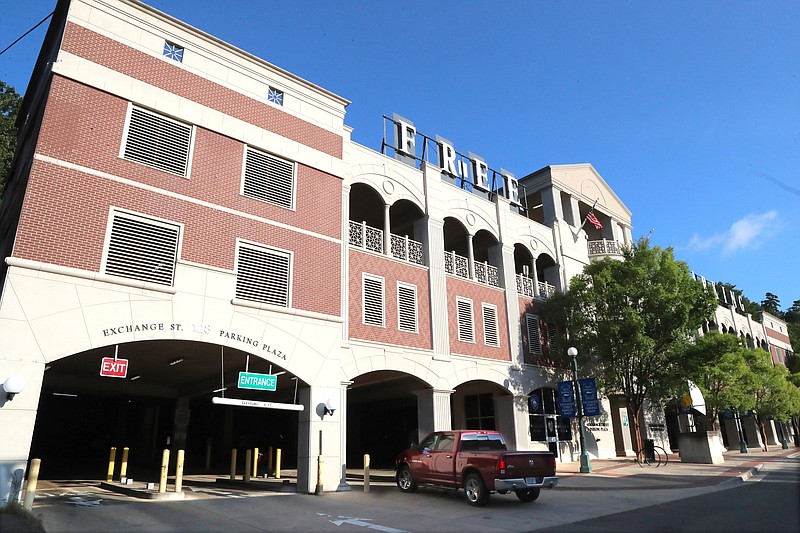The city wants residents and visitors to have more parking options downtown, but it's an expensive proposition.
City Manager Bill Burrough said $25,000 to $40,000 a space is the going rate.
"That's a lot of money when you're talking about 200 spaces," he told the Hot Springs Board of Directors Tuesday.
The 3,294 spaces Walker Consultants inventoried during its September study of the area from upper Central to Grand avenues are potential revenue generators, providing cash flow that could service debt on a parking structure.
Current parking revenues don't cover parking fund expenses. A $221,052 annual general fund subsidy is the parking fund's largest revenue source, dwarfing the $95,000 in projected revenue from the city's roughly 300 coin-operated meters.
"One of the goals of this board is to try to increase the amount of parking we have in our downtown area," Burrough, referring to one of five goals the 2021-22 board established for the 2023-24 board, said. "This is going to require additional decks, whether that's public or public-private partnerships, we're going to have to generate a certain amount of revenue to bond a project like that."
Moving worker parking to remote areas serviced by shuttles is a key element of the managed parking strategy Walker Consultants presented to the board Tuesday. Jim Corbett, who oversees planning, operations and technology practice for Walker's Southeast division, said understanding how much of the downtown inventory employees occupy will give the city a better sense for the number of spaces it needs to add.
"Once you move them out of those spaces, what does the new dynamic look like?" he told the board. "It's hard to project that. When you free up that inventory, then you can begin to digest and see what that looks like before we even begin to think about spending the first dime on breaking ground. It's one of the things that can be considered as initial steps before you start spending money."
The board hired Walker in August to develop a comprehensive parking management system for downtown, paying the out-of-state consultants $85,000.
The city has hired other consultants to study downtown parking and make recommendations. Thomas P. Miller & Associates was the most recent, receiving $250,000 for the 2016 Downtown Hot Springs Parking, Pedestrian and Bicycle Enhancement Plan.
The city contributed $25,000. None of the plan's recommendations, which included the removal of on-street parking from Central Avenue, have been implemented.
The city has stressed it intends to act on Walker's plan. Implementation is one of the deliverables in the city's contract with Walker.
Linking cost to demand was central to the pricing strategy Walker presented Tuesday. Parking was organized into tiers. The priority tier comprised 302 on-street spaces, most of which are on Ouachita and Central avenues from Market Street to Whittington Avenue.
Walker recommended a $2-an-hour rate, and a two-hour time limit, for the premium spaces, most of which are currently free or time-limited.
"We had some good feedback from business owners," Corbett told the board. "I was surprised that much of the community was in support of creating that turnover and getting more visitors to access the storefronts. This is certainly a way to do that."
The second tier included 198 on-street spaces on Canyon and Fountain streets, Convention Boulevard, Broadway and upper Malvern Avenue. A mix of 871 public and private off-street spaces was also included. Walker recommended a $1-an-hour rate and no time limit for the secondary tier.
Per city code, 25 cents an hour is the rate for metered spaces with a time limit of more than eight hours. It's 50 cents for meters with eight-hour or shorter time limits. Metered spaces are free from 7 p.m. to 7 a.m., except on weekends.
More than 400 remote on- and off-street spaces made up the free parking tier Walker proposed.
"Not everybody is going to want to choose to park close and pay for that priority experience," Corbett said. "If you want to be there, stage front, there's going to be a priority need for that.
"(The free tier) are areas for folks who aren't looking to pay a fee to park or aren't necessarily concerned about how close they are to their primary destination."
Corbett said tying price to demand helps cities manage parking.
"People start to think differently, and they start to park in different parts of downtown," he said. "Oftentimes it gets construed as kind of a money grab, but it's really about managing a limited resource."
Corbett presented a mix of payment options, including digital kiosks, parking apps or text pay. The latter asks drivers to text "park" to a number. They enter the parking space and license plate numbers and pay by credit card.
Corbett said mobile platforms generally don't charge cities for collecting and remitting parking fees.
"For the user, there's going to be a fee for that transaction," he said. "That could be anywhere from 15 to 25 cents per transaction. That's how the vendor makes their money."
Walker proposed the lot behind the federal building as a potential location for a parking structure. The old St. Joseph's Hospital infirmary on Whittington was also proposed. The city has agreed to demolish the building once the Arkansas School for Mathematics, Sciences, and the Arts no longer needs it, which could be as soon as next year.
Walker said the site of the old Ouachita Memorial Hospital on Market Street was also an option.
"Some of these sites you have I don't think will ever be able to materialize as a parking spot," Burrough told him. "Hopefully we'll see a public-private type venture where we've got more than just the city trying to build a parking deck. I think there's opportunities for that."
